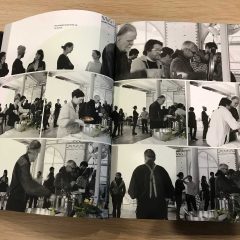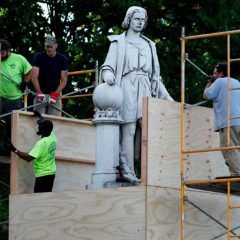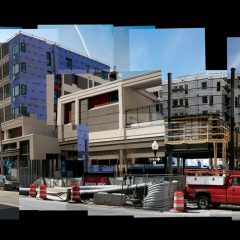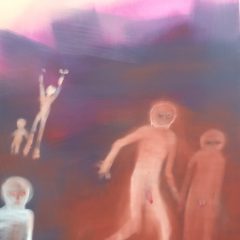Last summer, when Stella and I were in Karlsruhe in southwest Germany, the place was experiencing near-tropical Gulf Stream conditions. This year we dropped in on what was said to be the coldest, rainiest and most miserable May in thirty years. We don’t take the weather personally, so we went about our business, this year hanging out mostly indoors. Stella did some shopping — Karstad, the big German department store, for fabric; and Primark, the British clothing discounter, (like H&M on steroids, with more merchandise, more shoppers per square inch, and 10-Euro jeans made in Bangladesh – yes, Primark’s factory was in the building that collapsed last April). While everyone was jammed into Primark, the museums were nice and de-populated.
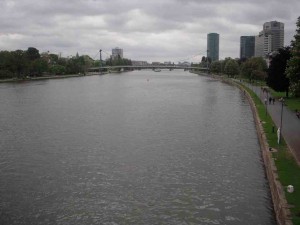
Matthew Day Jackson at ZKM in Karlsruhe
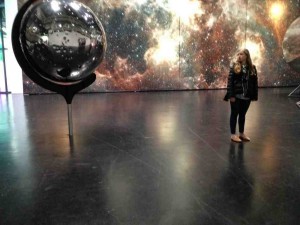
ZKM, the Center for Art and Media, is a huge laboratory for experimental contemporary art is housed in a former munitions factory in Karlsruhe. It is a cavernous industrial space and wonderful for American artist Matthew Day Jackson’s new show, Total Accomplishment, which sprawls across acres of space with multiple large video viewing rooms and looms upwards into a 2-story wooden structure resembling a house.
ZKM is also highly appropriate for Jackson’s pacifist- and nuclear arms-themed-exhibit. You may recall the artist’s celestial, neon-lit Conestoga wagon from the 2006 Whitney Biennial (picture here) — it was memorable in a show full of other memorable work (Urs Fischer, Zoe Strauss, Marilyn Minter, Matthew Monaghan – a very good biennial).

I bring that up because the piece of Jackson’s that greets you at ZKM, “Axis Mundi,” is reminiscent of that 2006 wagon. A large, re-purposed B-29 bomber cockpit sits on a metal stand that is based on a Buckminster Fuller design. It is first off a transportation relic of a bygone era. Second, it is both elegant, beautiful and chilling. And, situated on a kind of otherworldly pedestal, the piece becomes an icon. Nostalgic for a romanticized past with an afterburn of loathing for the object’s actual past history (the B-29 was used to drop the bombs on Hiroshima and Nagasaki), “Axis Mundi” exudes pretty much the same vibe the conestoga wagon did. The wallpaper backdrop — a blow up of a Hubble space telescope photo of the universe — turns the Axis Mundi into a bullet of bad that may be large on earth but is a mere blip in the larger scheme of things.
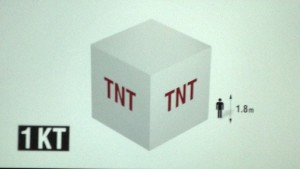
In addition to the big-boned sculptural elements in the show, Jackson’s videos are terrific. There’s a snappy anti-nuke video based on Charles and Ray Eames’ cult classic “Powers of Ten” (see it here). The Eames video explains “good” science, illustrated in factors of 10, for a general audience. Jackson’s video, also called “Powers of Ten,” uses the same framework to explain some “bad” science, specifically, the fallout zones from massive explosions of TNT and nuclear bombs.
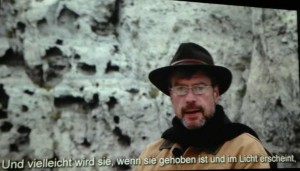
Jackson’s “In Search Of” video series also parallels and parodies an icon of the past, this time a TV show of the 1970s “In Search Of.” In the TV show, host Leonard Nimoy leads an exploration of the paranormal, things like the Easter Island, the lost city of Atlantis and UFO sightings (see the 70s show here). Jackson’s “In Search Of” follows the structure of the original, but with a shape-shifting host, David Thompkins, who starts out all seriousness in business atire and winds up garbed like Indiana Jones, belting down drinks at a bar and talking conspiratorially to the camera.
Jackson’s subject is pretty much the same as the original, but he deals with the kitsch end of the paranormal spectrum — ghosts, zombies and rock faces that resemble humans. The videos interweave footage from a couple of TV commercials for cars, which, oddly enough, fit perfectly, since they incorporate elements of the spooky and inexplicable (See Mercedes ghost commercial here). And they combine a lot of factual information and documentary film clips (Henry Ford’s creation of the assembly-line and mass-produced cars; Dwight Eisenhower’s cautionary speech about the Military-Industrial Complex) with some out and out hokum (like the tale of the artist, Matthew Day Jackson, who disappeared into the ether while searching for Eidolon, rock formations that resemble human faces.)
I could have watched the videos all day — they are a rich mix of information, entertainment and slick visuals. One complaint – the screening rooms abutted each other sharing common walls and the sound-bleed from one room into the other was more than a little distracting at times. Jackson is present in a couple of the films (he makes a great zombie); and he conscripts his parents in another, which is rather charming.
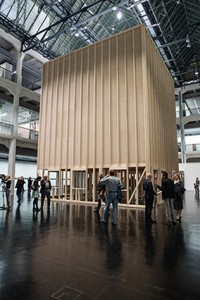
The other major sculptural elements in the show are a 2-story structure, “Kiloton Room,” and the large burned-wood relief map of Paris, “August 6, 1945 (Paris II) in Kiloton’s upstairs room (accessible by climbing the structure’s stairs). The map, quite beautiful and elegant in a Miss Havisham way shows the city as if it had been obliterated by a nuclear bomb.
Jackson provides a stack of giveaway posters in Kiloton’s first floor. They probably are not for everyone. What’s depicted, in a loose grid of black and white images, is a family of manikins sitting in the “Apple 2” test house in the Nevada desert, a 2-story house built by the US military and used to test the impact of atomic bomb blasts being set off there. Looking at the photos is creepy – like peeping a family photo album after a gut-wrenching tragedy befell them.
The artist, born in 1974 and clearly obsessed with themes that haunt many young artists – war and our survival on the planet — created a prodigious amount of work over the last few years. There are 19 pieces at the ZKM, all dating from 2009-2013 with the majority made in the last three years. It’s an impressive body of work and gives you a ton (or a Kiloton) of things to think about. The show is up at ZKM until Nov. 10.
By the way, artist Peter Weibel, the director of ZKM, has a Philly connection — Slought Foundation has shown his work on several occasions. Listen to a 72-minute audio podcast with Weibel.
Staatliche Kunsthalle Karlsruhe and Die Majolika Museum
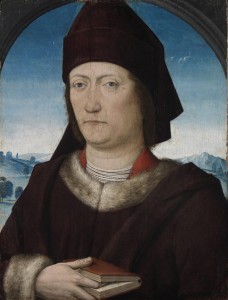
Portrait of a Scholar, 1480. Image from Staatlische Kunsthalle Karlsruhe
The small Staatliche Kunsthalle Karlsruhe has changing exhibitions in the first floor and a permanent collection of European Old Masters upstairs. Right now, a show by Japanese artist Leiko Ikemura — figurative ceramics and drawings — takes over the first floor. The works all convey a sense of displacement and loneliness. It is a very large body of work, and I was somewhat beaten down by the repetition of the one song it sung, that to be human is to be alone and lonely. In the permanent collection, there is a terrific Lucas Cranach room with lots of his portrait paintings.

The Majolika Museum, which accompanies a working ceramics studio and gift shop, is notable for its chronological display of decorative works dating back to the early 20th Century. The Hitler era was dealt with in a rather straightforward way, showing objects made there like a ceramic swastika and Aryan-looking workers in a wal frieze. There was a blow-up of an inventory list enumerating things for sale, like busts of Hitler. Oddly, while the rest of the museum’s displays are pristine and many objects are in vitrines, this particular corner of the museum is unkempt looking, with the objects coated in dust. What this signifies I do not know. Perhaps it’s a comment on how this era in German history is better left alone.
Frankfurt – The Stadel Museum with Olafur Eliasson’s new lighting installation
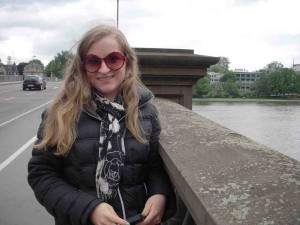
The ICE train got us to Frankfurt in an hour and from the train station it’s a 15-minute walk over the Main River to the Stadel Museum.
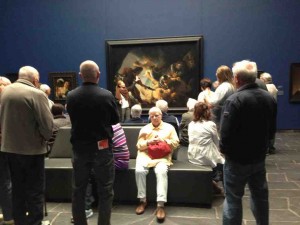
The Stadel is an encyclopedic museum of Western art, emphasizing the European tradition. Being familiar with American-style museums like the Philadelphia Museum of Art, t I was surprised that there is no art from non-Western traditions. We did see a museum of other cultures down the street, so I guess the tradition here is to split up the East/West discussion that way.
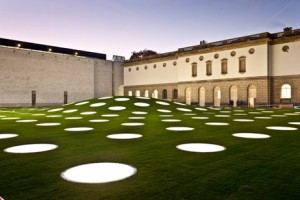

The Stadel just re-did its Contemporary wing, with a lighting installation by Olafur Eliasson, who created a grid of portholes in the ceiling that lets in light to the underground galleries and imbues them with a celestial space-voyager ambiance. It’s a great lighting scheme. The contemporary collection is significant, with works by Warhol and by many notable German artists – Gerhard Richter, Jorg Immendorff, Martin Kippenberger, Sigmar Polke, Rosemarie Trockel. I especially like the Thomas Demand wallpaper, which I take to be a commission by the museum, that looks like pinky-purple velvet curtain. Its placement in a large room that looks like a staging area for concerts, lectures or performances is pretty perfect.

Portikus – John Knight’s catalog-as-wallpaper installation
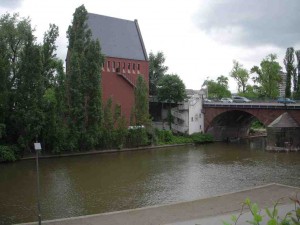
One final stop in our German museum roundup — Portikus, the experimental art hall on an island in the middle of the Main River, and just up-stream from the Stadel. The tall fairy-tale-like building is very inviting from the outside. Inside, there is one large white wall space with terrifically-high ceilings. The staff office and book/gift shop are in the lower level. Portikus is free — there is no admission charge.
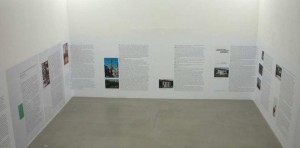
On view when we were there was Los Angeles artist John Knight’s catalog-cum-wallpaper which includes some photos and an interview with the artist. We didn’t stop to read it all, but noted its quirkiness with a smile and went down to the shop where we spied another quirky project, Portikus Water, 2001, by Jason Rhoades. I asked whether the water came from the river and the young docent said she did not know but doubted it, and anyway it was art so who could say. A great response.
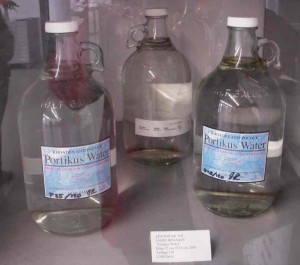
Geography outtake – a vineyard in Karlsruhe
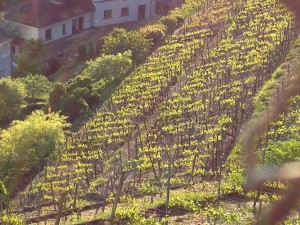
We climbed Turmberg mountain on the one sunny day of our trip and to our surprise we found vineyards up near the top on the sunny and incredibly steep slopes. Karlsruhe is very near the Black Forest and I guess this little Turmberg is a foothill.
More photos of Germany at my Flickr.


